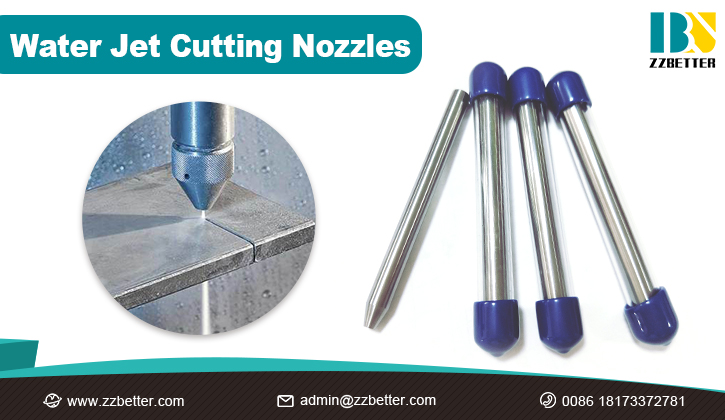What Is Abrasive Waterjet Cutting?
What Is Abrasive Waterjet Cutting?

Waterjet cutting is one of the most widely used processes in manufacturing. There are two different types of waterjet cutting. One is pure waterjet cutting, and the other one is abrasive waterjet cutting. In this article, abrasive waterjet cutting will be talked about from the following aspects:
1. Brief introduction of abrasive waterjet cutting
2. How does abrasive waterjet cutting work?
3. Features of abrasive waterjet cutting
4. Application of abrasive waterjet cutting
5. Advantages of abrasive waterjet cutting
6. Challenges of abrasive waterjet cutting
Brief introduction of abrasive waterjet cutting
Abrasive water jet cutting is specific to industrial processes, where you’ll need to cut hard materials like glass, metal, and stone using high pressure from an abrasive-water mix jet stream. The abrasive substances mixed with the water help to step up the speed of the water and thus, increase the cutting power of the water jet stream. This gives it the capacity to cut through solid materials.
Manufacturers discovered the abrasive water jet cutting method in the 1980s, founding that adding abrasives to the water stream was a good way to improve its cutting capacity, and this birthed a new list of water jet applications. The abrasive water jets followed the same operating principles as the pure water jets, however, their process differs due to the introduction of abrasive particles like garnet. Garnet mixed with the high-pressure water stream can erode virtually any material in its path with precision and speed.
How does abrasive waterjet cutting work?
The abrasive material mixes with the water and exits at high speed to cut the desired material. In most cases, olive sand and garnet sand are used as abrasive materials. If the cutting material is softer, corundum is used as an abrasive.
Abrasive waterjet cutting uses an abrasive particle (e.g. garnet) added to high-pressure water to cut through hard materials. The abrasive particle is added to the water in the nozzle of a waterjet cutting machine. In this operation, it is the abrasive particle that does the work of cutting the material. The role of the water is to accelerate the abrasive particle up to a speed suitable for cutting and to direct the particles to the chosen cutting point. An abrasive focusing nozzle and abrasive mixing chamber can be applied in abrasive waterjet cutting.
Features of abrasive waterjet cutting
An abrasive water jet cutting machine is 0.2mm larger than a typical water jet machine on average. With an abrasive water jet cutting machine, you can cut steel up to 50 mm and 120 mm of other metals.
There are also cutting heads on the market in which the two components, the orifice and mixing chamber, are permanently installed. These heads are more expensive to operate because they have to be completely replaced as soon as one of the components is worn out.
Application of abrasive waterjet cutting
Abrasive waterjet cutting is suitable for thick and hard materials, such as ceramic, metal, plastic, stone, and the like.
Advantages of abrasive waterjet cutting
· It is green technology. During the cutting, it does not leave behind any hazardous waste.
· It allows for the recycling of scrap metal.
· The close loop system allows the process uses very little water.
· It can cut various materials. Compared to the pure water jet and other cutters, it’s capable of handling just about any material ranging from bullet-proof glass to stones, metals, or materials having an even reflective or uneven surface.
· It generates little or no heat. The cutting process generates very little heat, so the sensitive materials remain intact and u compromised.
· Extremely High Accurate. The cutter is capable of making high-precision cuts or carving out 3-D shapes.
· It is very useful in drilling holes or intricate shapes.
· It can work on cavities that are inaccessible via other methods.
Challenges of abrasive waterjet cutting
· It will cost a long cutting time. Though the abrasive water jet cutter is capable of cutting most materials, it takes a very long time to do so, thus constraining the output.
· The nozzles are fragile and have a short lifespan.
· Mechanical Failure due to Low quality water jet orifices and other parts, causing production halt.
· With thick materials, the consistency in the impact of the water jet reduces with its distance from the nozzle, causing a decrease in the accuracy of the cut.
· It has high initial Costs. The cutting process may be revolutionary, but it takes a lot of capacity to start up.
· The abrasive material is very expensive and it cannot be reused. The abrasive water jet cutting process is not suited for working with soft material as the abrasive may get stuck to the workpiece.

If you are interested in a tungsten carbide waterjet cutter and want more information and details, you can CONTACT US by phone or mail at the left, or SEND US MAIL at the bottom of the page.





















